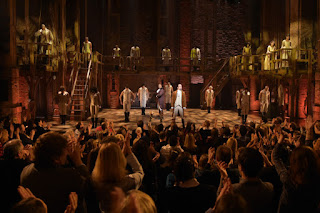A Live
What
is ‘Live’ in the context of art and performance? I would posit that for an
experience to be considered ‘live’ it involves a simultaneous shared space and
time between an action and a spectator.
Image Source: vulture.com
Peggy
Phelan states that the life of a performance is only ‘in the present.’[1]
And argues that liveness is defined by its ephemerality, its quality of
disappearance and non-reproductivity. Even when a staged theatre production is
repeated multiple times over many weeks or months, the elements of the
performance itself will inevitably be different at each showing.
A
quality of Liveness relies on semiotic and phenomenological individual
interpretation, and could be defined as a limited and liminal experience,
evoking an individualised reaction, and considering how we relate to the body
in simultaneous space and time.
Phelan
writes that Liveness ‘hinges absolutely on the sense of seeing oneself and of
being seen as Other.’[2]
Which, for me, reflects previous discussions on performativity and theatricality:
Liveness is the experiential interpretation of filling the space between self
and other.
Image Source: TimeOut.com
However,
to trouble this quality of Liveness, Philip Auslander discusses whether a
mediatized ‘live’ still qualifies, if the reflection of Phelan’s ‘gaze’ is a
critical quality for Liveness. Interestingly he notes that Live performance is
a very recent concept: Live is only understood in opposition to media or
recorded experience. Auslander writes that ‘the Oxford English Dictionary’s earliest examples of the word “live” in
reference to performance come from the mid-1930’s…’[3]
If
Liveness is a sense of a simultaneity, then even televised work such as The Great British Bake Off could be
considered in conjunction with this quality of Liveness, in that it is an event
experienced concurrently across a community, who are connected, not by
proximity, but through the immediate interventions provided by other forms of
media, such as Twitter.
Image Source: Channel4.com
#GBBO is a trending hashtag on Twitter during the broadcast.
#GBBO is a trending hashtag on Twitter during the broadcast.
Where,
then, is the Live located? Liveness may be considered to reside not in the
‘object’ but in the ‘subject’ – therefore is Live a matter of subject position?
Can a ‘live’ experience be the experience of an individual in an art gallery,
sitting in front of a piece of sculpture?
Phelan
writes that ‘Performance implicates the real through the presence of living
bodies.’[4]
If, as Phelan’s argument goes, Liveness is defined by shared proximity, shared
space, and shared time, then Auslander’s claim that ‘television’s essential
properties as a medium are immediacy and
intimacy.’[5]
throws this position into doubt since even live television provides a sense of
closeness and connection with the performer: a nearness that would not be
possible for attendees at the given space of performance. However if Liveness
relies on a reciprocal gaze then can even live television really be considered
Live, since there is no conversation between performer and audience taking
place?
Both writers agree that ‘Live performance now
often incorporates mediatization such that the live event itself is a product
of media technologies.’[6]
Theatre has always made use of current media and technological practises in an
attempt to enhance, not mask, the Live occurrence. This experience might be, in
Auslander’s opinion, subsumed into the recorded, but without the Live, the
record cannot exist. In a negative view, however the use of media in the Live
creates a sort of ‘hyper-reality’ wherein the Live and recorded work in tandem
to create an event which is more like a mediatized production than a Live one.
Phelan writes that ‘institutions must invent an economy not based on
preservation but one which is answerable to the consequences of disappearance.’[7]
The difficulty in this, though, lies in the concept of cultural capital:
theatre and performance relies on reproduction in order to be quantified in a commercialised
economy. In a materialistic culture, is the Live is merely a package for future
record and mediatisation?
Image Source: LinkedIn.com
Liveness foregrounds the I/Eye: I feel that it
is a state of reaction, emotion and individual interpretation. It is phenomenological
rather than theoretical: happening in the ‘here and now’. However, if the
present can only be experienced as a series of disappearing moments, can
anything be ever happening in the ‘now’ since the ‘now’ as we assimilate it is
always in the past? Liveness is an attempt to display this possibility and
capture the impossible by moving through a disappearing moment. To experience
the Live in a constant Now.
[1]
Peggy Phelan, ‘The Ontology of Performance: Representation Without Reproduction’,
in UnMarked: The Politics of Performance (London
and New York: Routledge, 1999), p.146.
[2] Peggy
Phelan, ‘The Ontology of Performance: Representation Without Reproduction’, in UnMarked: The Politics of Performance (London
and New York: Routledge, 1999), p.161.
[3]
Philip Auslander, ‘Live Performance in a Mediatized Culture’, in Liveness: Performance in a Mediatized
Culture (London and New York: Routledge, 1999), p.53.
[4] Peggy
Phelan, ‘The Ontology of Performance: Representation Without Reproduction’, in UnMarked: The Politics of Performance (London
and New York: Routledge, 1999), p.148.
[5] Philip
Auslander, ‘Live Performance in a Mediatized Culture’, in Liveness: Performance in a Mediatized Culture (London and New York:
Routledge, 1999), p.15.
[6] Philip
Auslander, ‘Live Performance in a Mediatized Culture’, in Liveness: Performance in a Mediatized Culture (London and New York:
Routledge, 1999), p.24.
[7] Peggy
Phelan, ‘The Ontology of Performance: Representation Without Reproduction’, in UnMarked: The Politics of Performance (London
and New York: Routledge, 1999), p.165.







Comments
Post a Comment